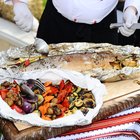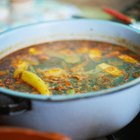
In a fast-paced world, the microwave can be a handy kitchen tool for families. From thawing to cooking, the microwave often plays a big part in putting meals together quickly. To keep you and your family safe, follow safety guidelines for cooking frozen food in the microwave, storing it in the refrigerator and reheating your meals.
Microwave Cooking
The microwave is best known for reheating food. It also makes thawing easier but it is able to cook frozen food as well. Not all foods cook the same in the microwave, however. Since the microwave cooks from the outside in, the middle of thicker foods will cook due to the surrounding heat of the food, as opposed to the microwaves. Frozen foods will take longer to cook. The downside to microwave cooking is that food tends to cook unevenly, potentially leaving cold or still-frozen spots. To ensure food is thoroughly cooked in the microwave, turn the food during cooking time even if the microwave has a turn table, use a covered dish with liquid, stir the food, debone meat and use a food thermometer to test that the food has reached the recommended cooking temperature, such as 145 degrees Fahrenheit for fish.
Cooking Containers
Cook food in containers that are labeled as microwave-safe. Use items such as oven cooking bags, heatproof glass, ceramic glass, paper plates or paper towels. For safety, avoid paper plates or paper towels with print. Cover food with a loose cover, such as a microwave-safe lid, plastic wrap, or wax or parchment paper — something that will allow the food to vent the steam that it creates. Do not let the plastic wrap touch the food. Never use brown paper bags, newspaper, containers that store cold foods, anything metal or foam-padded containers, and use aluminum foil sparingly — or not at all. Check with the your microwave's owner's manual and adhere to the foil-use specifications for your model.
Refrigeration
Storing cooked food in the refrigerator will help ensure safety and longevity. How long a particular food can be stored safely in the refrigerator depends on the type of food. The general rule for leftovers is 3 or 4 days in the refrigerator, according to the US Department of Health and Human Services. Store cooked food in the refrigerator within 2 hours of cooking or within 1 hour of cooking if the air temperature is 90 F or more. Cool the food at room temperature for about 20 to 30 minutes before refrigerating and store it in an airtight container. If you are cooking a large amount of food for future meals, portion out the food and store it in meal sizes.
Reheating
Reheating leftovers can be done in the microwave, oven or on the stove top. To reheat the food in the microwave, place the food in a microwave-safe container, cover it loosely with a lid, add liquid if necessary and reheat it until the food is hot and steaming. Stir the food, if possible, halfway through the reheating time. If you are reheating the food in the oven, place the food in an oven-safe dish, cover with a lid or aluminum foil and reheat it at 350 F until the food is hot. Reheat the food on the stove top by placing it in a pot or shallow frying pan. Heat the food over low to medium heat, covered and stir it occasionally to prevent sticking. Add liquid if necessary, and reheat it until the food is hot. Covering the food while reheating helps the food retain moisture.
Related Articles

How to Freeze Polenta

How to Use a Probe Cooking Thermometer

How to Cook With Saran Wrap

How to Preserve Food for Display

How to Store Dehydrated Foods

How to Cook With a Gas Fireplace

How to Use an Indoor Electric Grill

Can You Cook Frozen Foods That Are Past ...

The Positive Effects of Using a ...

How to Boil Ziploc Bags

Guidelines For Refreezing

How Long Can Frozen Food Sit Out Before ...

How to Cook Foil Packs in the Oven

Containers That Keep Food Hot

How to Make Pot Roast in a Cooking Bag

How to Make Sure That Foods Cook Evenly ...

How to Make Teriyaki Sauce

How Long Does Foil Keep Food Warm?

How to Soak Chicken in Cold Water

How to Freeze Polenta
References
Writer Bio
Nicole Adams is an accomplished writer, publishing in print and online. She has submitted hundreds of articles for websites, including CBS Local and Education.com. Adams earned a Bachelor of Science in psychology with concentrated studies in health and nutrition, and animal behavior and nutrition. She loves to cook and volunteers in animal rescue.
Photo Credits
Thomas Northcut/Photodisc/Getty Images